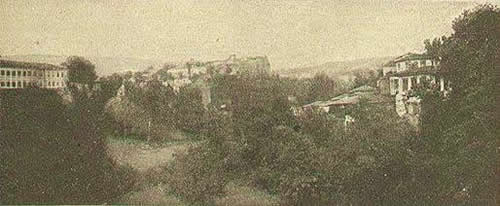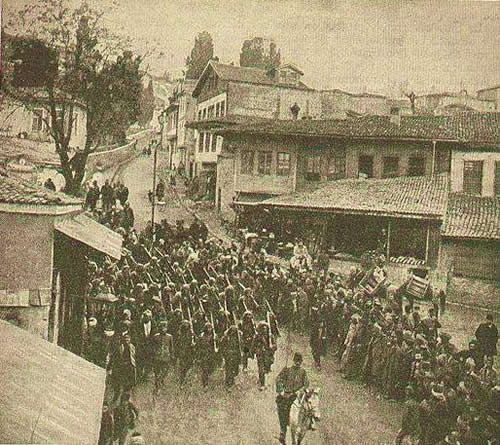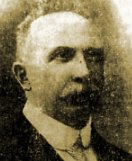| - |
Trébizonde - Trabzon - Տրապիզոն
Le Génocide de 1915
|
Lecture pour tous 15 mai 1916, XVIII-2 N#13,

Bâtie au flanc d'un plateau rocheux où s'étagent ses maisons aux couleurs voyantes, Trébizonde est l'un des plus grands ports de la Mer noire. L'armée turque y perd une de ses principales bases de ravitaillement. p.1252 |

Avant la chute de Trébizonde, arrivée d'un détachement de renfort turc - p.1255
|
Témoignages de 1915 sur Trébizonde
|
Reports from the American Consulate of Trebizonde
-
-
Si quelqu'un était Arménien, cela suffisait pour qu'il fût traité en criminel et déporté... Lorsque, par épuisement, ils devaient rester en arrière, ils étaient percés de baïonnettes et jetés dans le fleuve. Leurs cadavres ont été portés par les eaux dans la mer en face de Trébizonde, ou bien ils sont restés dans les endroits peu profonds, durant 10 à 12 jours, sur les rochers où ils pourrissaient, remplissant d'horreur les voyageurs qui étaient obligés de prendre ce chemin.... Un certain nombre de ces barques (kayik) chargées d'hommes quittèrent Trébizonde ; elles revenaient le plus souvent vides quelques heures après.
Rapport du 28 juillet 1915 (extrait) - Oscar S. Heizer
|
|
|
-
C'était une véritable extermination et un « Massacre des Innocents », des choses inimaginables, une page noire marquée par la violation flagrante des droits les plus sacrés de l'humanité, de la chrétienneté et des nationalités. Interview publiée dans « IL MESSAGGERO » du 25 août 1915
-
-
|
| - |
|
During WWI the Armenian population of the Ottoman Empire faced massive deportation and genocide. By the orders of the Young Turk government during Autumn
1914 and 1915, the majority of Armenians living in Western Armenia and other residential areas in Asia Minor was anihilated. The 60,000 Armenian population of the Trabizon Vilayet and city had a similar fate.
The belongings of the deported Armenians were confiscated by the local authorities or looted by the local population. Some native Armenians took refuge in remote mountainous areas and forests and organized self-defense troops.
On April 5, 1916 the Russian army occupied Trabizon. Of the 16,000 city Armenians only 15 women and 50 orphans survived. Of the 46 Armenian villages of the Vilayet, a total of 368 Armenians survived. Some 20,000 took refuge in Russia while all the others were deported or massacred.
To rescue the surviving Armenians the Caucasus Armenian Benevolent Union (Kovkasi Hayots Baregortsagan Miyutyun) sent a mission composed of members of its
Batumi Chapter, headed by Father Mesrob Melian. The latter became the representative of Catholicos Gevork V of Echmiadzin and established the Trabizon Armenian Committee with the permission of the Russian army command. The Committee rescued some 200 Armenian children who were being forcibly kept in Turkish homes. Most of these children were transported to Batumi, while the remaining ones were settled in Trabizon.
The Committee reclaimed the forfeited possessions of the Armenians including vineyards, lands and buildings, some 1200 houses, numerous shops, workplaces,
warehouses, and guesthoses. Keeping a record of the belongings was important to safeguard them from foreign trespassing as the Turkish authorities had entitled the Turkish population of the city to take ownership of Armenian belongings after the population’s deportation.
The presence of the Russian army enabled those who had taken refuge in remote mountainous areas to return to Trabizon at a daily rate of some 200-300. However, due to food shortages these people were transported to Russia.
After the 1917 February Revolution the attitude of the Russian authories gradually improved. They allowed the Armenians to manage their houses and belongings. The schools in the city started functioning, and life started to pick up. But the Bolshevik revolution changed the whole situation. In February 1918, after the Russian army quit the RussianTurkish front, the Turkish forces advanced forcing the Trabizon Armenians to leave.
The documents published in this article shed light on the rescue operation of the 1916-17 genocide survivors in Trabizon.
|
| - |



